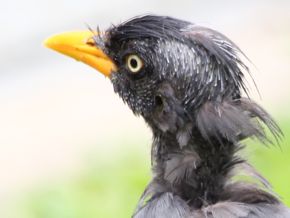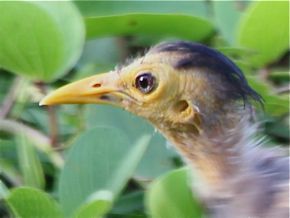“From the close-up images of the Javan Myna’s head (left top), it could be seen that this bird had lost quite a large patch of its feathers. Areas around its forehead, crown, neck, nape, chin and throat were affected. However, newly emerging *pin feathers(?) were seen to be covering these bald areas. *Or could they be remnants of old feathers that had been shed? The feathers on other parts its body appeared intact and relatively unaffected.
“Amongst the local avian species, the Common Mynas seem more prone to losing feathers on their heads (left bottom). Sightings of Common Mynas that are bald or botak are pretty common. Other species does not seem to have this problem. Although Javan Mynas are more abundant than Common Mynas, the sighting of this partially bald Javan Myna, was the first balding Javan that I have observed.
“Despite the common occurrence of bald-headed Common Mynas, very little is known on its cause. Moulting, fighting, nutrient deificiencies, and mites could be some of the causes that may contribute to the shedding of feathers. Coincidentally, on the same day that this Javan Myna was sighted, a Common Myna with a balding head was also seen. Except for its crown, this Common Myna had lost almost all its head feathers.
“I would be pleased if anybody can shed some light on the balding of the mynas. Why is the head affected, but not other parts of the body? Will new feathers grow in the bald headed Common Mynas? Tho se that I have seen did not seem to have any sign of new pin feathers emerging on their heads unlike this balding Javan Myna.”
Kwong Wai Chong
Singapore
8th September 2010
*The white shafts on the head of the Javan Myna are actually pin feathers – newly emerging feathers whose vanes have yet to burst out from their sheaths.











12 Responses
I very agree with the observations. I have observed and phtographed a Common Myna ( Acredotheres tristis ), in near Mysore, India which is bald. Initially I presumed it to be loss of feathers in a fight with another Myna. Mynas are very quarrelsome and they get into such squabbles very often. This was not the case her..there was a Pattern here, there was another Myna with the same pattern of feather-less head.It needs more study and observation to find the cause of these ” Baldness in Mynas”. I have also attached a picture of the bald Myna.
I had seen a Jungle Myna in Ipoh near my house that is suffering lost of feathers on the neck, I cant approach it too close as Jungle Mynas are very alertive compared to the other urban mynas, such as Common and Javan. It is true that so far Common is the only known species that will turn bald, however bald birds does not seemed to be seen around an area for a long time as I do had bald Common Mynas near my house but never consistently seen, unlike a bald-necked House Crow I saw in PJ for at least half a year until I left PJ. The most possible theory is a feather moult, feather moult differs for each species, probably Common Myna has evolved to understand losing the head feathers at once will not affect survival, unlike loosing flight feathers at once, showing that this moulting may had started to develop within the Common Myna species itself, maybe some similar looking Acridotheres mynas such as the Indian’s Bank Myna could be observed to see if they share similar characteristic.
Mynas are known to carry parasite that caused ten cents rashes on human beings. There was a industrial safety problem many years back in the warehouse I worked where hundreds of mynas take refuge for the nite. One day industrial rashes broke out among warehouse staff. An industrial skin specialist eventually identified the cause as the mynas when someone turned in a parasite specimen found on his skin. Maybe this is what is causing the baldness common among mynas.
There are many theories about this. Perhaps this link might give you a clue:
http://www.bootstrap-analysis.com/2006/08/bald_birds.html
I believe that the birds are just molting. They replace their feathers once or twice a year. And sometimes they molt at different parts of the body at different times
It is unusual to see a Javan mynah with a bald head. But baldness in Common Mynahs is not unusual, and has even been mentioned in early ornithological publications. In my old house, I used to feed mynahs regularly with aviary leftovers and a pair of Common Mynahs were resident for several years. One or the other of them would periodically shed the feathers from the head, but these always grew back within a few weeks, after which the bird would look perfectly normal.
Hi all, this is just a theory, i think it’s evolution, the birds are adapting. The same reasons why vultures are bald; No feathers on its head means less chances of food or dirt getting stuck in it. We can see mynahs going through bins and even carcasses. Mynahs are considered as scavengers nowadays.
I have a pet Indian Mynah and he has looked similar when he has a big molt. His head can be patchy and bald for months before the feathers start to grow back. I have had him checked by my local avian vet and he is in perfect health with no parasites at all. He is also very well fed, in excellent body condition and mentally stimulated. It is a mystery!!
My parents keep telling me the birds ate too much salt/ate salty food and that led to their head being bald…so poor ;_;
I spotted one today, Sydney Australia, Indian myna. Only a bald head and face with a little peach fuzz like comb over on the top of his head. I have never seen this before but my instincts are telling me it’s some kind of mite.